The weapon of the Second World War. Guns of high flying and understanding
In general, an arms race in the air is a very peculiar matter. And here progress has gone a long way, because literally at the end of the 30's, two rifle machine guns were considered normal weapons. And literally in 6-7 years, four 20-mm guns did not surprise anyone. Killed - yes, but not surprised. This has become the norm.
But I still consider the epic of development those monsters whom brilliant engineers nevertheless managed to stuff into airplanes. Or was it already the plane was going around the gun? It’s hard to say, because - to take off!
Long thought how to sort their heroines. And he decided, without further ado, to arrange them in increasing caliber.
40 mm Vickers Class S gun. UK
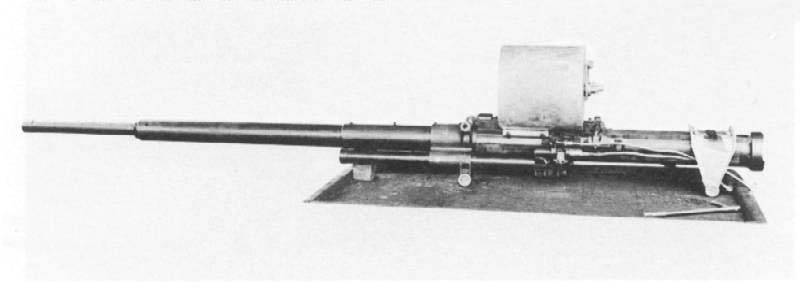
It should be noted that it was the British who pioneered the installation of large-caliber (by aviation standards) guns in aircraft. It is difficult to say who they were going to shoot such shells in the 1936 year, but it was then that the Vickers and Rolls-Royce were given the task of developing an 40-mm gun for installation on an aircraft.
The Vickers gun won the competition, and it began to be mass-produced and installed on airplanes.
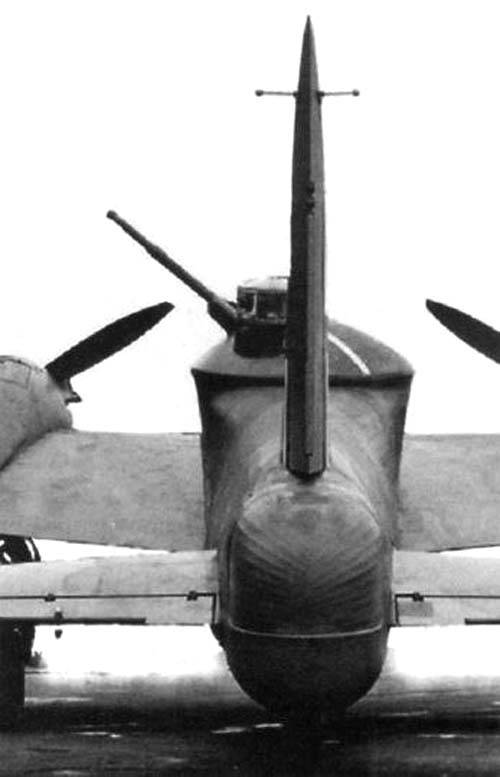
The most interesting thing is that the gun was first installed on bombers. Wellington and B-17. And these aircraft worked on enemy submarines, and quite successfully. The 40 mm projectile performed quite well.
In 1940, when the Wehrmacht showed what it might be capable of tank the troops, when properly managed, in the military department realized that a 40-mm armor-piercing projectile is something that can be opposed to tanks. In principle, it is logical that the armor of the “panzer” I and II was quite capable of it.
Engineers from the Hawker Aircraft were able to make changes to the design of the Hurricane fighter, allowing the S cannon to be placed under each wing.
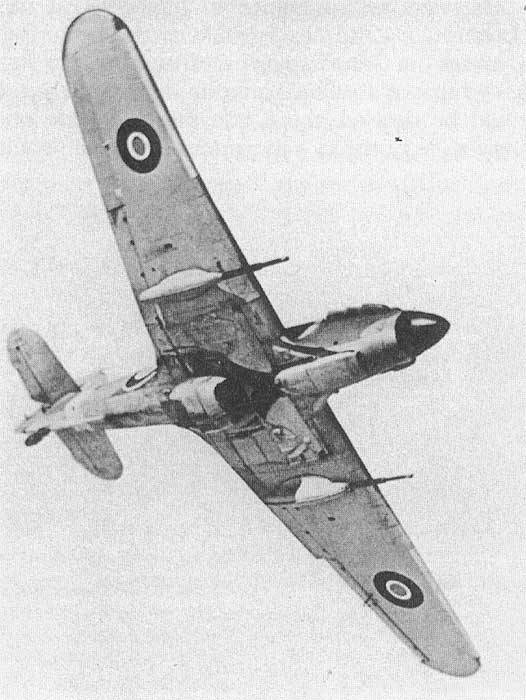
For this, an entire installation was designed to accommodate a gun and a magazine that stubbornly did not fit in the thick wing of the Hurricane. But designer P. Higgson coped.
In general, everyone believed that the Mustang would be much better than the Hurricane, but the wing of the P-51 required more global improvements.
During the tests, there were some incidents. The test pilot was not prepared for the fact that when fired from both guns, the plane would actually stop and fall at a peak. To solve this problem, a recommendation was made to the pilots during the opening of fire to choose the aircraft control stick for themselves.
S cannons were aimed through a conventional Mk.II reflex sight, but in addition, the aircraft had two Browning 0.5 sighting machine guns loaded with tracer bullets.
The first unit to receive the Hurricane Mk.IID with 40-mm guns was the sixth squadron, based at the Shandar Egyptian air base. The baptism of fire of the Hurricanes Mk.IID took place on June 7, resulting in the destruction of two tanks and several trucks. In total, during the operations in Africa, the pilots of the 6 squadron fire 40-mm guns disabled the 144 tank, of which 47 were completely destroyed, as well as more than 200 light armored vehicles.
It is clear that these were light tanks with bulletproof armor.
But it was paid, and, cruelly. The suspension of such guns reduced the already not-so-huge speed of the Hurricane at 60-70 km / h. It turned out that the Hurricanes quite calmly beat the Germans' equipment, and the German Bf-109F quietly shot down the Hurricanes.
With the adoption of the Hurricane Mk.IID missiles, they began to withdraw units from service. A number of aircraft were transferred to the Far East to Burma, where the 20 squadron was very efficiently used.
The Vickers S cannon was actually used on a large scale only in battles in North Africa and Asia, where lightly armored targets were enough for its shells. Gradually, it was abandoned in favor of rockets, but statistics showed that during combat operations in the Asia-Pacific Region the average accuracy was 25% (for comparison, the accuracy of a volley of 60 unguided missiles when attacking a tank type target was 5%). Accuracy when firing high-explosive shells was twice as high as when firing armor-piercing. This was due to the fact that high-explosive fragmentation shells had a more similar ballistics used for shooting machine guns Browning 0.5.
Advantages: a large projectile weight, a large damaging effect, high accuracy in a single shot, the guns were put in a pair, that is, one shot - two shells.
Disadvantages: huge returns during long firing, low initial speed, low rate of fire, ammunition is small (15 rounds per barrel).
45-mm gun NS-45. the USSR
To begin with, we recall two good designers, without which there might not have been much of anything in our aircraft guns.
Yakov Grigorievich Taubin and Mikhail Nikitich Baburin, baldly blamed by the denunciations of colleagues and shot. But the potential that they laid down in their projects developed at OKB-16 subsequently allowed the creation of a whole family of large-caliber air guns, which were in service with Soviet aviation in the next 30 years.
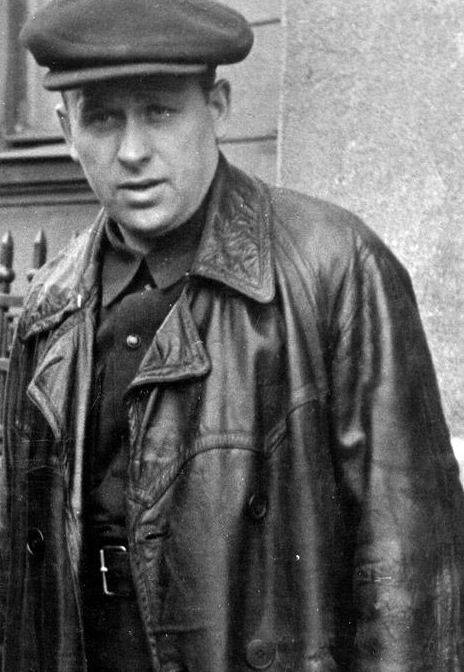

In the previous article about large-caliber air guns, we noted the very successful design of the NS-37 gun, which was a refinement of the PTB-37 gun Taubin and Baburin. The gun was developed by A.E. Nudelman and A.S. Suranov, and they gave the name to the cannon.
A relatively light and quick-firing gun for its class, with excellent ballistics, it was capable of destroying any enemy aircraft with a couple of hits and confidently fighting armored vehicles, at least from an early period.
However, the development of armored vehicles at the 1943 level of the year made the gun ineffective. In connection with this state of affairs, in early July of the 1943, a GKO resolution was issued on the development of an 45 mm caliber air gun.
Today, of course, it is very simple to evaluate everything that happened several decades ago. And very comfortable. What is easy and understandable today, during the war was given later with blood. Today it’s very easy for me to write such a decision into a controversial one. And then, and in the wake of the success of the Il-Xnumx with the cannons of the Shtitalnaya Sh-Xnumx of the caliber 2-mm and the cannons of the Nudelman and Suranov of the same caliber ... Apparently, they simply did not have time to really evaluate all the consequences of installing these guns. Not before that, and today it is understandable and justifiable.
Meanwhile, no one canceled physics even during the war, and if today it is clear that the higher the cartridge’s energy, which consists of the mass of ammunition and its initial velocity, the higher the return weaponsacting on the design of the carrier glider. But then you needed a weapon that could hit the enemy.
And Nudelman and Suranov could. They were able to process their NS-37 under the cartridge 45x186. The prototype of the 45-mm gun 111-П-45 appeared less than a month after the task for its development. It is clear that the lion's share of the cannon assemblies was saved from the NS-37, which, however, cannot be said about the results.
Initially, only the barrel with the chamber and the receiver with newly designed tape links were processed. However, the first tests showed that the recoil force of the gun ranged from 7 to 7,5 tons. There were doubts that an aircraft capable of withstanding such an impulse would be available. Quickly made a muzzle brake.
The version with a muzzle brake was designated NS-45M, but since it was she who went into the series, the letter "M" in the designation was usually omitted.
As in the case of the 37-mm NS-37 gun, the main carriers of the 45-mm guns were the Il-2 attack aircraft and the Yak-9 fighter.
With IL-2 did not work out at all. Although the idea was quite, the guns were installed in the root of the wing, more precisely, under it, together with a fair amount of ammunition in 50 cartridges. And then there was an imposition of oscillations of the wing and trunks when firing.
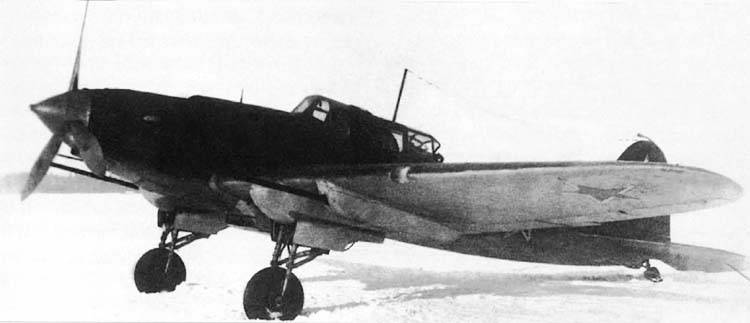
Targeted shooting at ground targets was not possible due to the strong vibration of both the gun itself and the wing. A similar situation, although to a lesser extent, developed with the 37-mm version of Il, which had been discontinued by that time, so the work of equipping the 45-mm attack aircraft with guns lost all meaning. A few shots and in return an airplane with flying wings is doubtful.
With the Yak-9 miracles began immediately. The inner diameter of the motor shaft M-105PF, through which the gun barrel passed, was 55 mm. And the diameter of the barrel NS-45 was ... 59 millimeters!
And so that you can skip the gun barrel inside the shaft, its thickness was reduced from 7 millimeters to 4's.
By the way, this even reduced the weight of the gun. HC-45 weighed 152 kg, and HC-37 weighed 171 kg. It is clear that you have to pay for everything. Naturally, the resource of the barrel itself fell, plus the long, but light barrel began to “play” when firing, which affected accuracy.
To reduce this harmful business, a special device with a ball bearing was installed on the screw sleeve, centering the gun shaft relative to the axis of the hollow shaft of the gearbox.
In general, it turned out. And the Yak-9K went into the series (albeit a small one), but failed to repeat the success of the Yak-9T with the NS-37 cannon.
When firing from the NS-45 cannon, the recoil affected the aircraft much more than with the 37-mm caliber. The greater the flight speed and dive angle, the less impact the aircraft had on the recoil. When firing at speeds less than 350 km / h, the aircraft turned sharply, while the pilot made abrupt back and forth movements in his seat.
Targeted shooting was possible and effective at speeds greater than 350 km / h, and in short bursts of 2-3 shots. The high recoil force of the NS-45 gun had a significant impact on the design of the aircraft, leading to the leakage of oil and water through various seals and cracks in pipelines and radiators.
Nevertheless, the tests, in general, were found to be satisfactory, and during the period from April to July of the 1944, a military series of 53 Yak-9K was built.
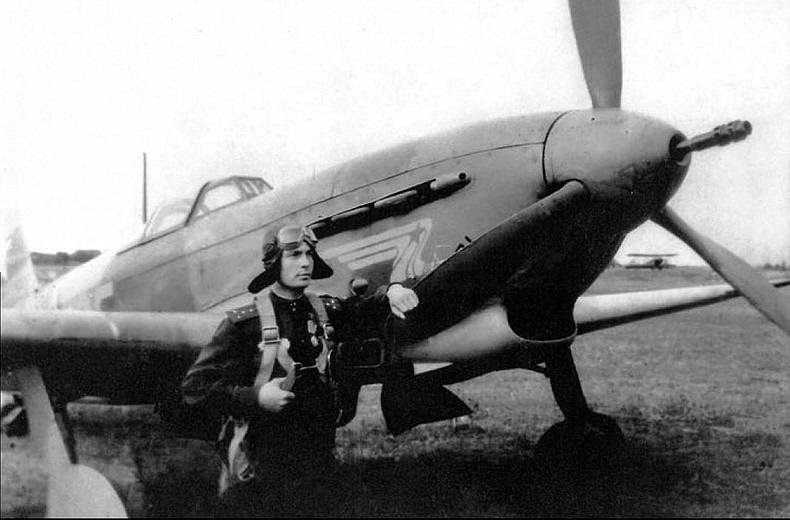
Troop tests were 44 Yak-9K. 340 combat sorties took place with a total raid of 402 h 03 mines, an 51 air battle took place. The opponents were FW-190A-8, Me-109G-2 and G-6. 12 enemy fighters were shot down (there were no meetings with bombers), including 8 FW-190A-8 and 4 Me-109G-2; their losses - one Yak-9K.
The average consumption of ammunition of caliber 45 mm per one shot down enemy aircraft amounted to 10 shells.
Nevertheless, the war was coming to an end, and the military tests of four dozen Yak-9K, it was decided to limit. He did not go into the series. This ended the military service of the NS-45, most of the cannons (194 pieces) that remained unclaimed.
Advantages: good ballistics, destructive shell, light weight, decent ammunition.
Disadvantages: recoil, low barrel life, difficulties with installation and maintenance.
57-mm air gun No-401. Japan
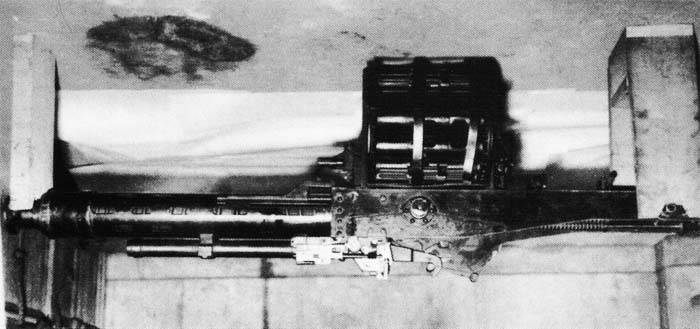
The ancestor of this monster was also an 37-mm gun. But-203 was such a successful design that, on orders from above, Dr. Kawamura decided to pump his brainchild with steroids to the caliber of 57 millimeters.
This happened in the 1943 year, when it turned out to develop a system under the low-power cartridge 57x121R for the 57-mm tank gun Type 97. The automation scheme of the new 57-mm air gun completely repeated the earlier No-203 caliber 37 mm.
Even outwardly the guns were very similar, the difference was in the presence of the No-401 muzzle brake.
The power of the No-401 gun was carried out from a closed drum-type magazine, similar to that used on the 37-mm No-203. The magazine capacity was 17 rounds.
Unfortunately, in spite of the good weight and size parameters for such a caliber (the weight is only 150 kg), But-401 inherited from its predecessor all the negative characteristics, of which there were a lot.
A short barrel and a small charge of the cartridge gave a parabolic trajectory and a low initial velocity of the projectile. And the rate of fire at 80 rounds per minute was, let's say, very low. Plus the return was great and shot down the scope.
So all these minuses predetermined the use of the gun exclusively for assault operations, when in one approach it was possible to make only one aimed shot.
The exact number of No-401 guns made is unknown, the approximate quantity is determined in the region of 500 pieces.
The only aircraft that was designed for this system was the Kawasaki Ki-102 Otsu heavy twin-engine attack aircraft, in which the No-401 was compactly located in the bow, only slightly protruding beyond the dimensions of the aircraft.
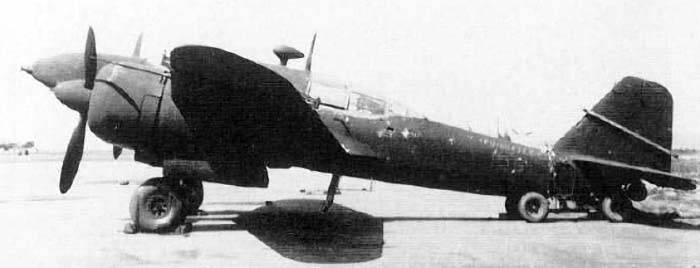
In 1944-45, these machines were built in 215 units, but they were hardly used in battles. They were cared for to counteract the expected landing of the allies on the Japanese islands. Later, part of these attack aircraft was re-equipped with the new 37-mm No-204 guns, turning them into heavy interceptors.
Pluses: light weight, good ammunition
Disadvantages: low rate of fire, disgusting ballistics, weak cartridge for such a heavy projectile.
Molins 6-pounder Class-M. Great Britain
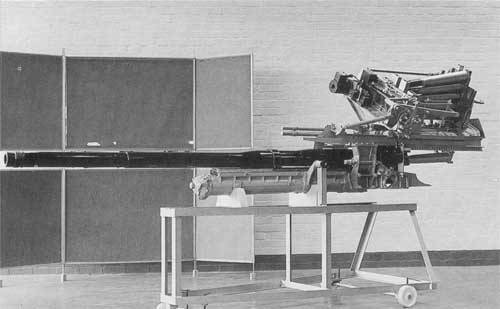
At the beginning of the 1943 year, the Air Force Command began discussing the replacement of the Vickers S 40 mm anti-tank guns mounted on Hurricane IID aircraft. The armor grew thicker, the shells of the 40-mm guns became less and less dangerous for it.
For the sake of replacement, it was designed by a group of specialists led by G.F. Wallace is truly a monstrous gun Molins.
In tests, the gun showed itself on a very good side, and the only thing that could interfere with its use on airplanes was possible problems with the automatic feeding and loading from overloads (from 3,5 g) arising from maneuvering.
On the other hand, who will shoot from such a gun, maneuvering so actively?
It is clear that there was no talk of any re-equipment of the Hurricanes, since the gun weighed almost a ton. Plus the return was "just" 4,5 tons. Although, in principle, for such an instrument there are not so many.
Therefore, they decided to stuff this gun into the Mosquito, fortunately, his nose was still empty. Or almost empty.
It is worth recalling that the "Mosquito" was a wooden plane, it was based on balsa. Lightweight and durable. But 4,5 tons of returns - this is 4,5 tons of returns.
Static tests were carried out and the balsa withstood. So there were anti-submarine "Mosquito" with 57-mm gun in the nose of the fuselage.
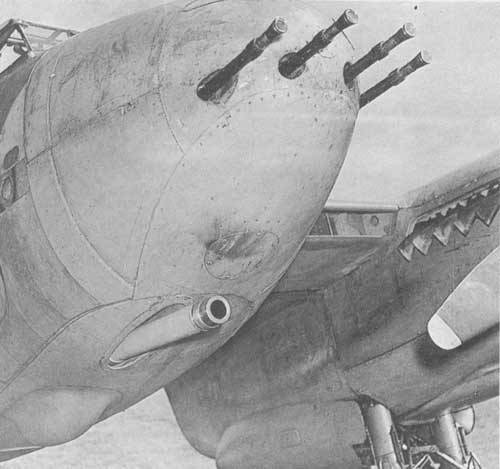
Molins were placed at a slight downward angle and 100 mm to the right of the longitudinal axis, while the gun barrel protruded from the fuselage by 610 mm. The return spring was under the barrel.
And even did not have to throw machine guns. There were different options, with four, two 0.303 Browning machine guns with double ammunition. A machine gun is generally a useful thing, you can throw tracers for shooting, you can explain to anti-aircraft gunners that we would have to scatter through the cracks ...
It was interesting to implement a system for collecting cartridges that were not thrown out, as they could actually damage the tail of the aircraft. Sleeves remained inside the aircraft, in the trap.
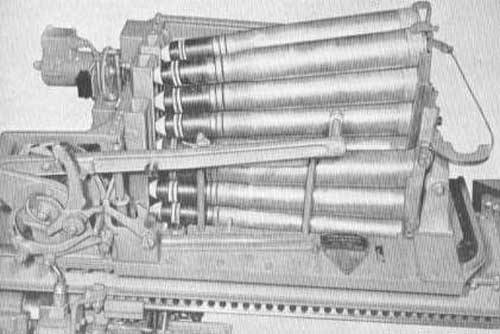
For aiming, the Mk.IIIa reflex sight was installed.
The Molins gun was officially named the Airborne 6-pounder Class M, and the Mosquito, armed with this colossus, became known as the Tse-Tse.
A mixed anti-submarine 248 squadron was formed, armed with the Bofayters and Mosquito-Tse-Tse.
The first combat mission Mk.XVIII took place on October 24 1943 year. Mosquitoes were looking for enemy submarines, and on November 7 of the same year the first combat clash took place. A pair of "Mosquito" discovered a submarine in a surface position. Having received several hits in the wheelhouse, the boat plunged, surrounded by black smoke.
But for the first time pilots were able to reliably drown a German submarine on 25 on March 1944 of the year, off the coast of France.
Advantages: you just had to hit the target. The shell took over the rest.
Disadvantages: gun weight, only armor-piercing shells were included, low rate of fire.
75 mm M4 aircraft gun. USA
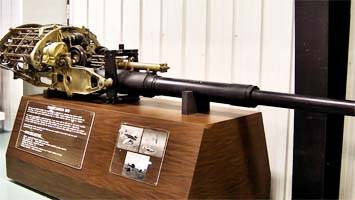
Well, really, but what was the little thing? There probably would have been an opportunity, the Americans would have inserted an 152-mm howitzer into the plane. Well, so they had everything - the most, and not a cent less.
In general, the Americans in this regard were well done. Yielding to the temptation to hit everything that can be reached from the aircraft, including ships, they brought this idea not just to the series, but fired B-25 armed with 75-mm guns in a very decent amount.
It all started quite long before the war, in 1937. Probably from the British, they got infected overseas. The terms of reference for the development of a cannon aircraft included armament with a caliber of not more than 75 mm, with moderate rate of fire and unitary cartridges.
As the aviation version of the 75-mm gun, the M2 serial guns with a barrel length of 28,47 caliber and M3 with a barrel length of 37,5 calibers were chosen. Both guns were the development of the old French field gun Matériel de 75mm Mle 1897, which was in service with the US Army.
They wanted to equip the M2 short-barrel with an escort fighter, and put the M3 long-barrel on a bomber. After reflection, they left only M3.
It is characteristic that the Americans, having analyzed the tactics of using large-caliber aviation systems, came to the conclusion that the high recoil of the guns still would not allow to aim more than one shot. Accordingly, do not complicate the design of the gun with automatic reloading.
And from the 1943 of the year, B-25 armed with M4 or M5 guns began to appear in theaters of operations. The difference, in general, was in the machine.
In general, it turned out really flying SPG. M4 was mounted on a carriage under the seat of the second pilot, taking also part of the bomb bay. Almost a three-meter trunk had to be put somewhere.
The crew of the aircraft consisted of two pilots, a shooter, a radio operator and a navigator, who was appointed loader. In addition to the M4 gun, two fixed machine guns of 12,7-mm caliber with ammunition for 400 rounds per barrel were installed in the nose of the fuselage. The gun and the front machine guns were aimed at the target by the pilot. The aircraft was equipped with the N-3B optical sight and the A-1 bombing artillery sight. In addition, for sighting it was possible to use the course machine guns. When the target was under machine gun fire, the cannon was launched.
On average, they managed to fire a cannon three times in a single combat approach. A theoretically well-trained crew could provide the M4 guns rate of fire up to 30 rounds per minute, however, as a rule, in practice the rate of fire did not exceed 3 - 4 rounds / min.
The B-25G and B-25H cannon attack aircraft armed with the 75-mm M4 and M5 guns proved to be very useful in the Pacific for attacking small transport ships and Japanese submarines, in the hunt for tanks and anti-aircraft batteries. In Burma, when attacking the oil fields of Laniva, one of the Mitchell attack aircraft, firing only 4 shells, launched a firestorm at the oil storage.
Cannon Mitchells were also used in the Mediterranean in the hunt for shipping.
It happened that the stormtroopers had more serious goals: on 8 on June 1944 of the year, 30 miles from the city of Manokwari, New Guinea, a group of two B-25N from the 345th bombing group of the USA with the fire of 75-mm guns launched even the Japanese destroyer "Kharusami" displacement of 1700 tons. For the destruction of the ship and the death of 74 crew members, it was necessary to successfully hit only five 75-mm shells.
But in Europe, cannon attack aircraft did not take root. Affected by a better counteraction to the Luftwaffe and air defense. For them, the B-25 was just a target, as its speed dropped to 110 km / h and a slow attack aircraft (maximum speed dropped to 450 km / h) became an easy target.
However, only B-25H were released about 1000 pieces.
Advantages: any target in the teeth, a powerful projectile with good ballistics.
Disadvantages: slow rate of fire due to manual reloading.
75-mm aircraft gun VK-7.5. Germany
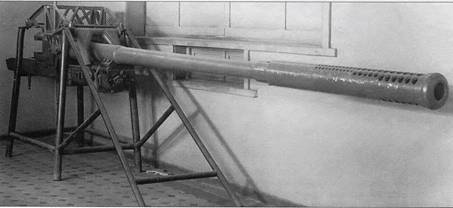
Well, the quintessence of destruction. The German monster created by the gloomy geniuses of the Rheinmetall-Borzig immediately after the VK.5 (50-mm anti-tank gun adapted for the aircraft).
If the main idea of the development of the 50-mm gun was the desire to defeat enemy bombers beyond the range of their defensive weapons, then the 75-mm gun was considered as a weapon for assault operations.
The Americans, too, were not small in terms of caliber. Why should the Germans be behind?
I would blame the Germans for some excess and gigantomania. But I can not help but admire their design ideas. Because it is necessary to be able to automate the usual land anti-tank gun PaK-40. And the Germans managed.
In ordinary life, it was a semi-automatic gun with a horizontal wedge bolt, and here they also added new products. The gun used very powerful 75 × 714R unitary cartridges, effective against any modern anti-Hitler coalition allied tanks.
In general, it was possible not to be driven like that, and to use the shortened KwK 40 tank guns, which used less powerful 75x495R cartridges, more suitable for arming the aircraft, as an initial sample.
But no, if to do so, so that Valhall would be welcomed with open arms. And in 1942, VK 7.5 appeared, it is also PaK 40L, that is, for the Luftwaffe. The name was later changed to BK 7.5, where the word “Bordkanonen”, an aircraft gun, was hidden behind the letters “BK”.
And from the tank gun, the electric ignition of the C / 22 or C / 22 St electro-fuse sleeve was borrowed, which was installed in the standard cartridge instead of the capsule.
The pneumatic automatic loader, in general, repeated the VK 50 structurally used on the 5-mm cannon, using the pneumatic cylinder that sent the cartridge to the gun chamber. However, the ammunition pattern was significantly different and varied depending on the medium on which the gun was installed.
One of the first projects on which the gun was planned to be installed was the Junkers Ju-88 bomber.
When the tests passed, and everyone understood that the 88 was a strong machine and would not fall apart from the shooting of this monster, everyone breathed a sigh of relief. And they launched the gun into the series.
The electro-pneumatic charging system was just modified, the gun received a clip for 10 cartridges. True, usually only 8 cartridges were loaded in it, plus one in the breech of the gun. In flight, in the holder it was possible to load more cartridges than the shooter of the lower rear machine gun turret was engaged in.
In addition to the cartridges in the holder, the ammunition of the aircraft also included 7 cartridges.
The automatic charging mechanism made it possible to achieve a technical rate of fire of around 30 rounds / min., Although in reality, no more than two shots could be fired in one go.
The military tests of several produced serial Ju.88P-1 took place in the autumn of 1943 of the year on the central section of the Eastern Front in the division of Versuchskommando fur Panzerbekamfung.
As the first battles showed, the rate of fire of the VK 7,5 gun was so low that in one attack the pilot managed to fire no more than two shots, although usually even one direct hit was enough to set fire to any tank.
Since information on the combat use of Ju 88P-1 is practically absent, we can conclude that their successes were very modest.
Subsequently, they refused to use the VK 7.5 guns on the Junkers assault, preferring to replace them with less powerful, but more rapid-fire VK 3.7 and VK 5 on subsequent submodifications “P”.
Thus, on the VK 7.5 cannon at the beginning of the 1944 of the year one could put a bold cross, recalling it only in the context of one of the examples of the “miracle weapon” of the 3 Reich, but they remembered it at the very end of the war, using offensive as the main armament attack aircraft Henschel HS 129.
It was necessary to do something with the Soviet tanks, especially with the ISs. Yes, hitting the 75-mm shell from above was guaranteed to disable any of our tanks, but ... 700 kg units turned the Henschel, albeit devoid of 20-mm guns for the sake of relief, into something that hardly hobbled at a speed of 250 km / h and miraculously kept direction of flight after each shot.
129 was not a model of controllability and fluttering like a butterfly in the best of times, and after installing VC 7.5 everything became completely sad.
Nevertheless, VC 7.5 decided to give a second chance and launch a new attack aircraft in mass production. Anti-tank attack aircraft received the index Hs.129B-3 / Wa and the unofficial nickname "can opener" (Buchsenoffner).
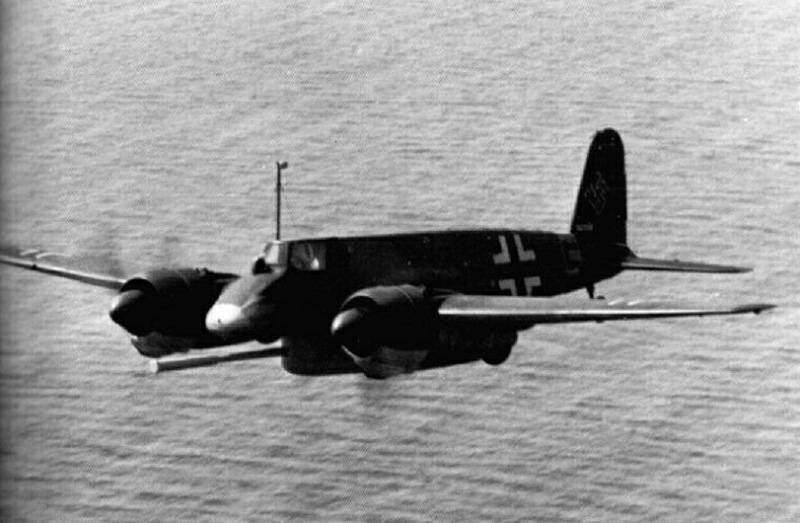
During July-October 1944, the Germans managed to produce approximately 25 aircraft of this type, which were sent to the Eastern Front. They say they took part in the battles for the Zeelovsky heights and even knocked something out there. It seems like 9 of our tanks.
I can’t judge how true this is. If it’s clean, I’m sure that the tanks, if anyone knocked out, were ground artillerymen. And the Henshels, if they flew out, with such speed and controllability, most likely, were simply shot down.
Do not forget the spring of 1945. And the total advantage of our aircraft. So - most likely, a fairy tale from the losers.
However, this does not detract from what the guys from Rheinmetall-Borzig created. It was a good job, anyway. Especially when you consider that the VK 7.5 could shoot the entire range of ammunition from the PaK 40 anti-tank gun. All that was needed was to replace the impact capsule with the C / 22 or C / 22 St.
Advantages: the incredible power of the shell, good ballistics, excellent armor penetration.
Disadvantages: rate of fire.
Yes, a simple glance to evaluate the use and success of large-caliber air guns is not easy. As practice has shown, a large caliber on planes did not take root (except for gunships in the USA) and gave way to medium-caliber guns, with a less powerful shell, but a higher rate of fire. Well, missile weapons played an important role. But these guns made their (albeit not very large) contribution to history artillery.

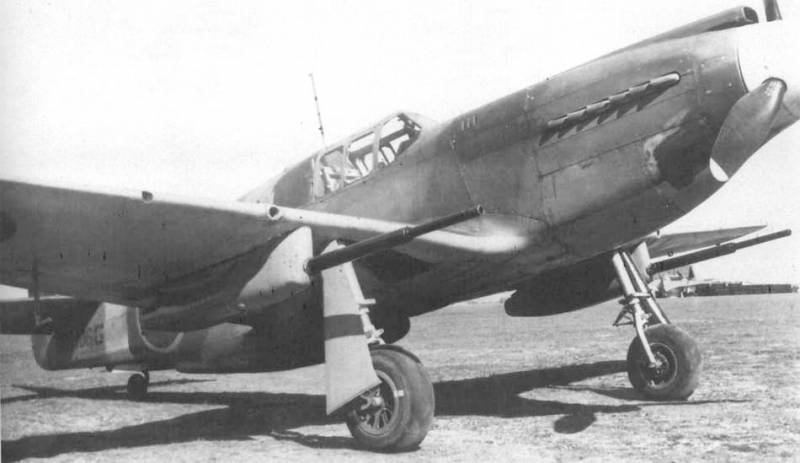
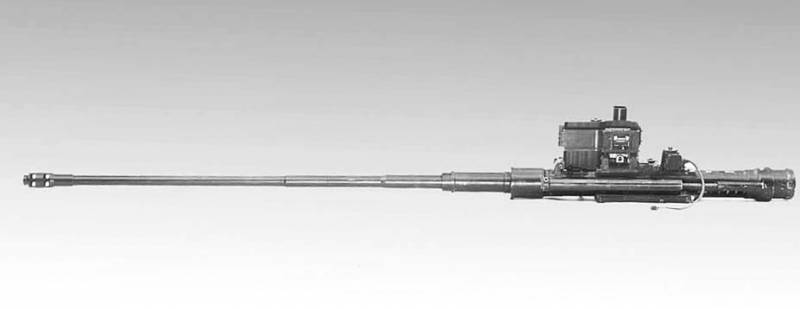
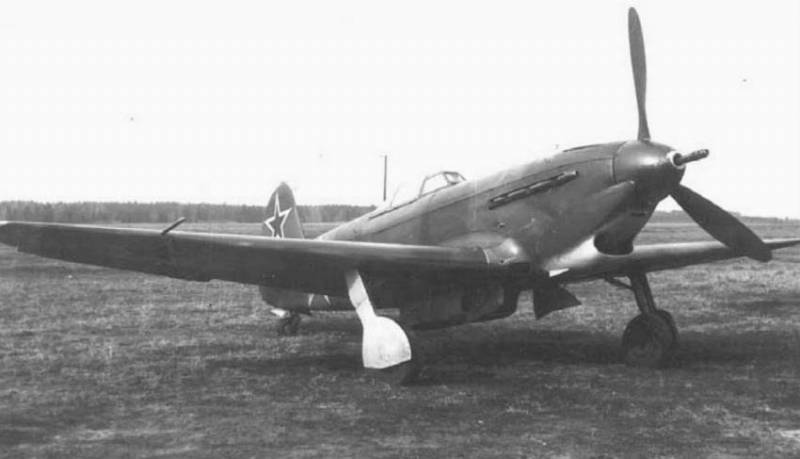
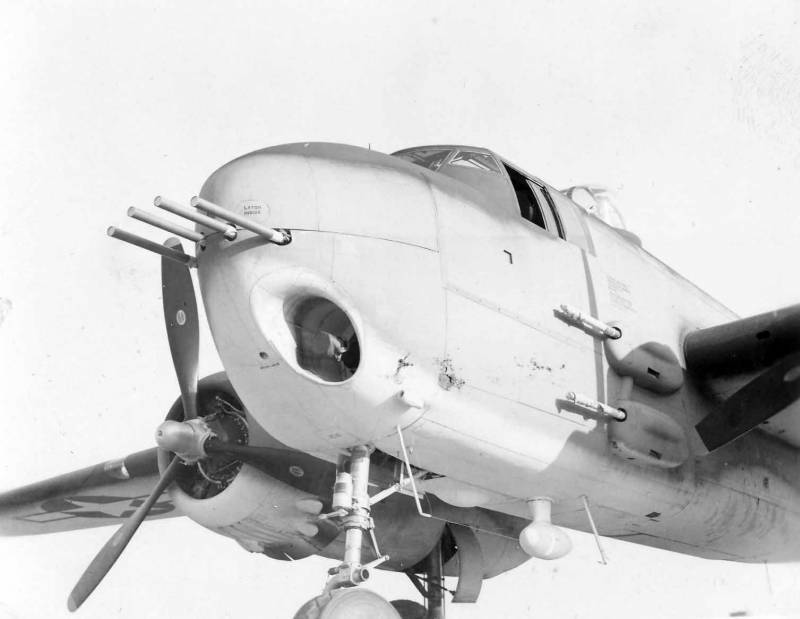
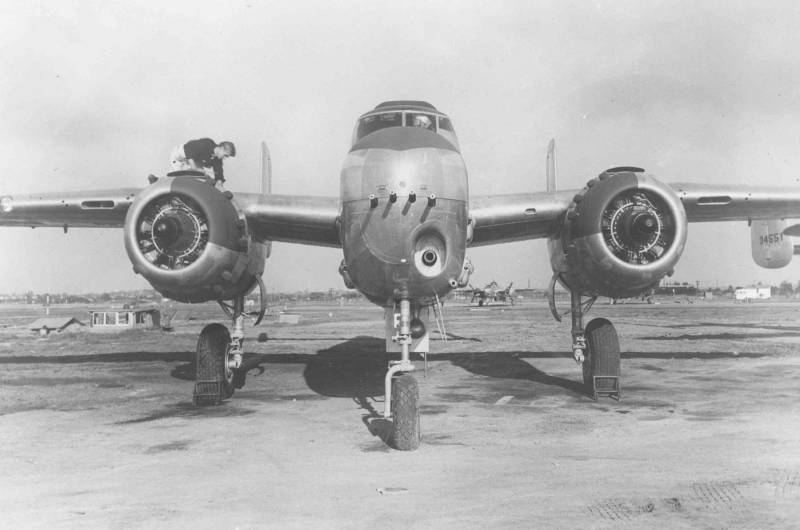
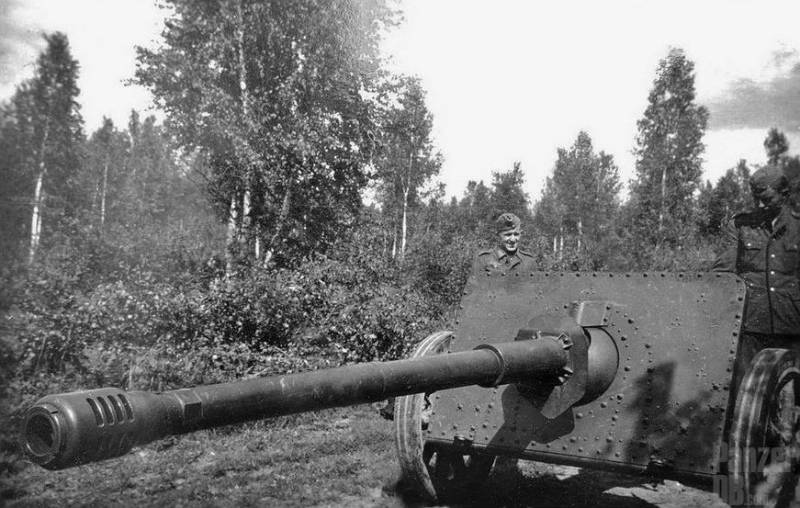
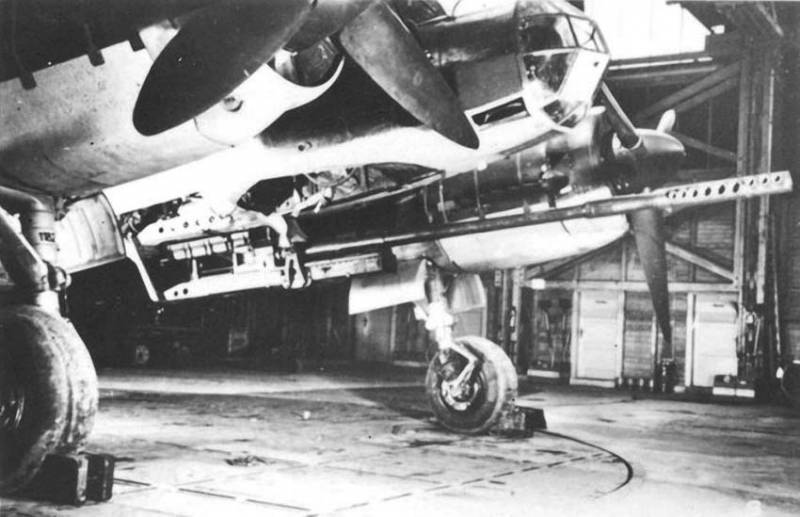
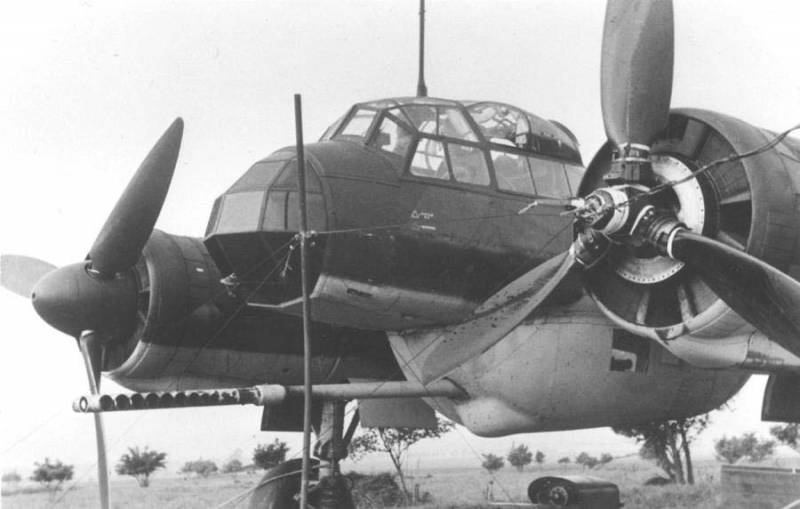
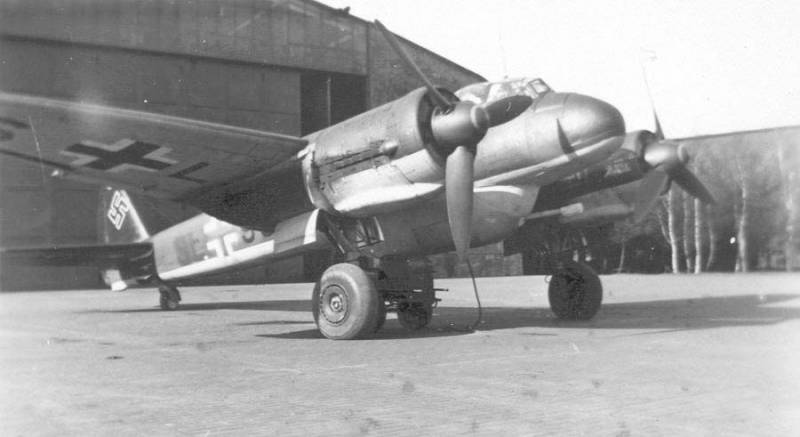
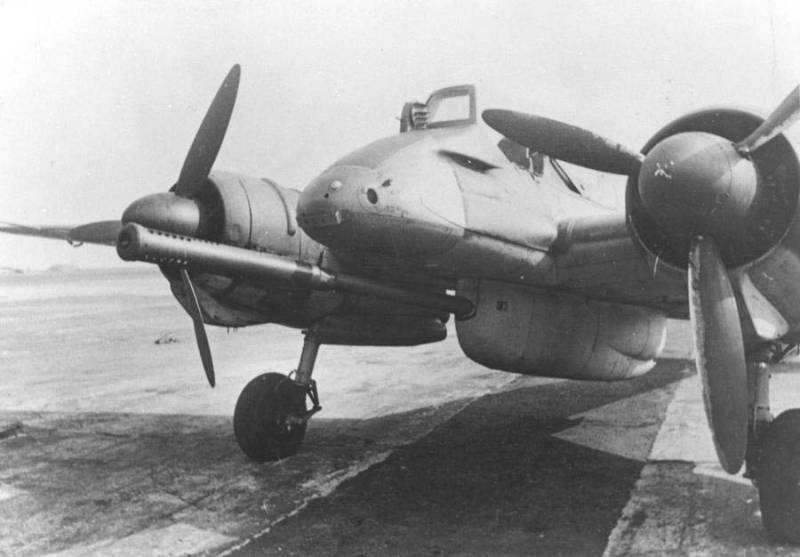

Information